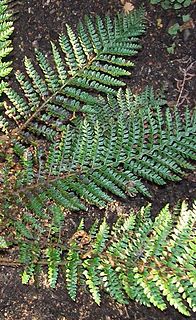Alsophila costularis, synonyms Cyathea chinensis and Sphaeropteris chinensis, is a species of tree fern native to Yunnan in China, Sikkim in India, as well as Nepal, Myanmar, Laos and Vietnam. Plants grow in forest and montane forest at an altitude of 900–1800 m. The trunk is erect and 1–2 m tall. Fronds are bipinnate and 1–2 m long. The stipe is either long and warty or has short spines towards the base as well as scattered glossy dark brown scales with fragile edges. Sori occur near the midvein of fertile pinnules and are covered by thin indusia.
Lastreopsis subrecedens is a species of fern in the family Dryopteridaceae. It is endemic to China. Its natural habitat is subtropical or tropical moist lowland forests. It is threatened by habitat loss.

Lastreopsis, known as shieldfern, is a genus of ferns in the family Dryopteridaceae, subfamily Elaphoglossoideae, in the Pteridophyte Phylogeny Group classification of 2016.

Rumohra adiantiformis, the leather fern or leatherleaf fern, is a species of fern in the wood fern family Dryopteridaceae. It has a wide distribution, mainly in the tropical Southern Hemisphere.

Polystichum proliferum, commonly known as mother shield fern is an Australian endemic fern. The genus name Polystichum is derived from Greek poly - many, and stichos - rows referring to the many rows of sori. The species name is derived from Latin, Proli – offspring and fer - bearing referring to the proliferous buds, a prominent feature of the species.

Angiopteris evecta, commonly known as the king fern, giant fern, elephant fern, oriental vessel fern, Madagascar tree fern, or mule's Foot fern, is a very large rainforest fern in the family Marattiaceae native to most parts of Southeast Asia and Oceania. It has a history dating back about 300 million years, and is believed to have the longest fronds of any fern in the world.

Gleichenia rupestris is a small fern growing in eastern Australia. Referred to as one of the coral ferns. The specific epithet rupestris refers to it being seen growing near rocks.

Lastreopsis decomposita, known as the trim shield fern, is a common plant found in eastern Australia. The habitat is rainforest or moist sheltered eucalyptus forests. It may form large colonies. This fern features delicate lacy fronds, up to 90 cm long. The segments are alternate on the stem, hairy and thin textured.

Lastreopsis silvestris, known as the mountain shield fern, is a rare plant found in eastern Australia. The habitat is high altitude rainforest on the McPherson Range, on the border of the states of New South Wales and Queensland. The habitat has high rainfall; mists and fogs are frequent. The original specimen was collected by Cyril Tenison White in December 1918, he described them as being “very abundant”.

Parapolystichum microsorum, synonym Lastreopsis microsora, known as the creeping shield fern is a common small plant found in eastern Australia and New Zealand. The habitat is rainforest or moist sheltered eucalyptus forests. It may form large colonies. The specific epithet microsora translates to "small sori".

Elaphoglossoideae is a subfamily of the fern family Dryopteridaceae. It has previously been regarded as the family Elaphoglossaceae. As circumscribed by the Pteridophyte Phylogeny Group in their 2016 classification, the subfamily excludes the Polybotryoideae, which are kept separate. It can be divided into three clades: the bolbitidoid ferns, genus Pleocnemia, sister clade to the bolbititoids, and the lastreopsid ferns, sister to the combination of the first two clades.

Lastreopsis nephrodioides is a fern in the family Dryopteridaceae. The specific epithet refers to its resemblance to Nephrodium decompositum R.Br..

Podochilus australiensis, commonly known as the native stream orchid, is a species of epiphytic or lithophytic orchid. It has a fern-like appearance with many thin, twisted, glossy green leaves and clusters of up to six dull white or greenish flowers with a green labellum. It grows tropical North Queensland.
Oenotrichia is a genus of ferns in the family Dennstaedtiaceae in the major group Pteridophytes, and was described as a genus in 1929. It is native to New Caledonia.
Shield fern is a common name for ferns in several genera and may refer to:

Parapolystichum acuminatum, synonym Lastreopsis acuminata, is a small plant found in eastern Australia. Common names include creeping shield fern, glossy shield fern and shiny shield fern. It is a widespread fern, often seen in wet eucalyptus forest or rainforest, usually near streams.

Lastreopsis hispida, known as the bristly shield fern, is a common plant found in New Zealand. Less often seen in Australia, in cool rainforest areas with humus rich soils, or more rarely as an epiphyte on tree ferns or mossy logs. Listed as endangered in the state of New South Wales where it grows in a few remote sites in the Blue Mountains, such as at Mount Wilson. The specific epithet hispida is from Latin, meaning "bristly".

Parapolystichum munitum, synonym Lastreopsis munita, the naked shield fern is a plant found in tropical and subtropical forest areas in eastern Australia. Often seen in large colonies, near streams in rainforest and wet eucalyptus areas, north from the Barrington Tops.













